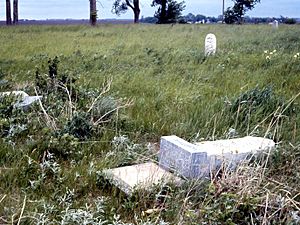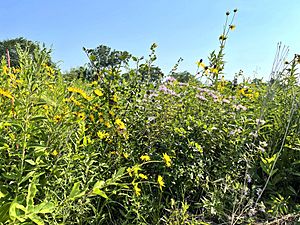Cemetery prairie facts for kids
Cemetery prairies are special places where small parts of the original North American prairie still exist. These areas were saved because they were used as burial grounds by early settlers. This meant the land was not plowed, so the natural prairie plants and animals could keep living there. Think of them as accidental nature preserves!
Native prairie plants, like many grasses, are perennial, meaning they grow back from their roots each year. Plowing destroys these roots and the whole ecosystem. Today, very little of the original prairie is left, making these cemetery prairies incredibly valuable.
In 1974, a prairie expert named John Madson said that most surviving tallgrass prairies are quite small. For example, in Iowa, there are about 200 to 300 small cemetery prairies, covering only about 1,000 acres. This is less than 0.1 percent of Iowa's original grasslands! Illinois, known as the "Prairie State," has only about 2,300 acres of original prairie left. Fifty of these acres are found in 29 historic cemeteries. Besides cemeteries, some prairie patches also survived on rocky hillsides or along railroad tracks because these areas were hard to farm.
These small prairie patches in cemeteries are very important for scientists. They act as "control groups" or untouched examples that scientists can compare to areas that have been farmed or restored. This helps them learn how to bring prairies back to life. The special seeds and plants found in these cemeteries can also be used to help restore larger prairie areas. Scientists even use cemeteries to study how much topsoil is lost over time. For instance, one cemetery prairie in Illinois stands about 1 foot higher than the surrounding cornfield. This shows how much better perennial prairie plants are at holding soil than annual farm crops.
Some cemetery prairies have been forgotten over time, while others are still active burial grounds. In both cases, taking care of them can be tricky. Roads that once led to these cemeteries might have disappeared, making them harder to find but also protecting them.
Contents
What is Prairie?
Prairie lands were generally found in the central part of North America. This huge area stretched from places like Tulsa in the south to Winnipeg in the north, and from Indianapolis in the east to Bismarck in the west. In the eastern parts, the grass was tall, while in the west, it was shorter. Only a few trees, like cottonwoods or burr oaks, usually grew near streams. The rest was a vast "sea of grass."
How Prairie Stays Healthy
Wildfires and animals grazing on the land actually help a healthy prairie stay strong. Fires clear out old plants and help new ones grow. Grazing animals also keep the prairie open and prevent trees from taking over.
As an expert named Aldo Leopold explained in 1942, fires helped the prairie by thinning out grasses but also encouraged many other important plants to grow. These plants, like prairie clover and wild indigo, have special roots that add nitrogen to the soil, making it rich and healthy.
Plants and Animals of the Prairie
The types of native plants found in cemetery prairies can vary a lot. A study in the 1970s looked at cemeteries in Illinois and Indiana. They found that important prairie grasses like big bluestem and Indian grass often survived near tombstones and along fences, even in cemeteries that were mowed a lot. In some cases, the whole cemetery was still prairie. In others, prairie plants were only found in untouched areas, like along the edges.
Tallgrass prairies are home to many different kinds of plants. A healthy native prairie can have more than 150 plant species! For example, Rochester Cemetery Prairie in Rochester, Iowa, which is a very well-studied cemetery prairie, has an amazing 360 plant species. Smaller cemetery prairies usually have fewer species, but a survey in Illinois found an average of 114 native prairie and savanna species per site.
Some of the many plants you might find in an untouched cemetery prairie include:
- Indian grass
- Big bluestem
- Little bluestem
- Compass plant
- Wild indigo
- New Jersey tea
- Shooting star
- Blazing star
- Wild strawberry
- Bird's-foot violet
- Black-eyed Susan
- Leadplant
- White prairie clover
- Purple prairie clover
- Switchgrass
- Stiff goldenrod
- Porcupine grass
- Prairie dock
- Rattlesnake master
Many animals also live in prairies, such as partridges, badgers, turtles, coyotes, beavers, and many types of birds.
Cemetery prairies are also important for insects. A 2012 study looked at moth diversity in Illinois. They compared native prairies (including two cemetery prairies) to fields growing crops for biofuel. The native prairies had the most different kinds of moths. This study showed that turning large areas into single crops can harm insect diversity. It suggests that farm areas with many different native plants will have more helpful insects than large fields of just one crop.
Cemeteries can also be home to other valued plants, like wild asparagus, which people enjoy gathering.
As one expert, Domenico D'Alessandro, noted, these preserved sacred lands are very important for nature. Even though they are burial grounds, the ones that were not constantly mowed like typical lawns became safe places for native plants to survive.
Caring for Cemetery Prairies
Taking care of cemetery prairies is a special job. It often involves people who know a lot about prairies but also understand how to care for historical items like grave markers. Managers must protect the old tombstones and respect the cultural importance of a burial ground, while also maintaining the natural area.
Experts say that prairies need a mix of "care and neglect" to thrive. Cemeteries that are burned or cleaned once a year tend to do best. Regular controlled burns help stop tree seedlings and unwanted plants from taking over the native grassland. When doing burns, managers must be careful to protect the stone markers. They remove extra brush or fallen trees from around the markers to prevent heat damage. They should never use fire-retardant chemicals on the gravestones.
Unwanted plants in cemetery prairies usually fall into two groups: common weeds that grow easily in disturbed ground, and old plants or trees that were planted as part of the grave site. With grave plantings, managers have to find a balance between protecting the natural ecosystem and preserving the historical look of the cemetery. Invasive plants like brome and red clover can be removed by annual spring burns, sometimes followed by a special spray that targets cool-season grasses. This allows the native seeds in the soil to grow back. Unwanted trees can be girdled (a ring cut around the trunk), which kills them but leaves them standing as snags, which are good for wildlife.
List of Cemetery Prairies
- Bigelow Cemetery Preserve, Ohio
- Brown School Road Cemetery, St. Joseph, Michigan
- Brownlee Prairie Cemetery Nature Preserve, Illinois
- Calvary Catholic Cemetery, St. Louis
- Clay Prairie, Allison, Iowa
- German Methodist Cemetery Prairie State Nature Preserve, Lake County, Indiana
- German Settler Cemetery, La Paz, Indiana
- Goewey Township Cemetery, Osceola County, Iowa
- Harrison Cemetery Prairie, southwest Michigan
- Hess Cemetery near Eagle Point, Illinois
- Horton Township Cemetery Prairie Preserve, Osceola County, Iowa
- Johnson Cemetery, Hillsdale County, Michigan
- Loda Cemetery Prairie, Illinois
- Mount Hope Cemetery, Barry County, Michigan
- Munson Township Cemetery Prairie Nature Preserve, north of Cambridge, Henry County, Illinois
- Pellsville Pioneer Cemetery, Butler Township, Vermilion County, Illinois
- Prospect Cemetery State Preserve
- Queen Anne Prairie Cemetery, Woodstock, Illinois
- Rochester Cemetery, Cedar County, Iowa, established in the 1830s on 13.5 acres of hills in sand prairie-savanna grassland near the Cedar River
- Smith Cemetery Prairie Nature Preserve, Darby Township, Madison County, Ohio
- Sumnerville Cemetery, Cass County, Michigan
- Tomlinson Cemetery, Champlaign County, Illinois
- Weston Cemetery Prairie, Yates Township, McLean County, Illinois
See also
- Insular biogeography (how species live on islands or isolated patches)
- Sacred grove (another type of protected natural area)
- Involuntary park (places that become parks by accident)
- Urban prairie (prairies growing in cities)
- List of protected grasslands of North America



